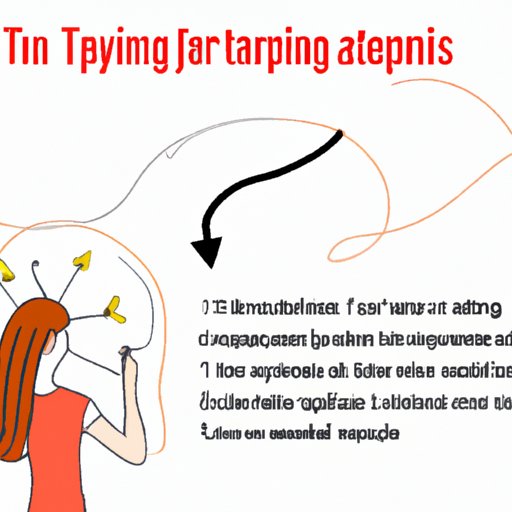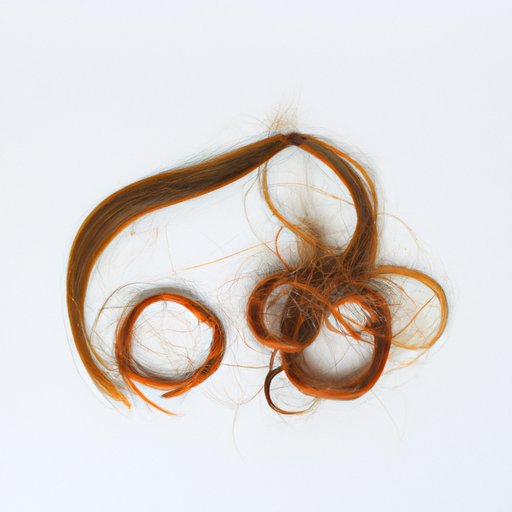I. Introduction
If you find yourself frequently struggling with knots and tangles in your hair, you’re not alone. Hair tangling is a common problem experienced by people of all hair types and lengths. In this article, we’ll explore the science behind hair tangles and offer practical tips for preventing and managing them, so you can achieve smooth, healthy hair.
II. The Science Behind Hair Tangles: Understanding Hair Structure and Causes of Knots
Before diving into specific prevention and management techniques, it’s helpful to understand why hair tangles in the first place. The structure of each individual hair strand contains cuticles, overlapping scales that can become raised and rough when subjected to friction or damage. When cuticles catch on each other, knots and tangles are formed.
Several factors can exacerbate hair tangling, including friction caused by tight hairstyles or rough fabrics, static electricity, and product buildup. Understanding these triggers can help you avoid contributing to further tangling of your hair.

III. 10 Tips to Prevent Hair Tangling
To achieve smooth, tangle-free hair, take note of these ten tips:
- Avoid over-washing your hair, which can strip it of natural oils that protect against tangling. Instead, try washing your hair every other day or as needed.
- Use a gentle, sulfate-free shampoo and conditioner to help prevent buildup on the scalp and hair.
- Avoid brushing your hair when it’s wet, as this can cause breakage and more tangles. Instead, use a wide-toothed comb to distribute conditioner and gently detangle your hair in the shower.
- Apply a leave-in conditioner or detangler to hair before brushing, to help create a protective barrier against friction.
- Avoid using heat tools like hair straighteners and curling irons too frequently, as this can damage the hair cuticles.
- Avoid tight hairstyles that put strain on your hair, like tight ponytails or buns.
- Invest in a silk pillowcase, which can reduce static and minimize friction while you sleep.
- Trim your hair regularly to prevent split ends, which can cause tangling further up the hair shaft.
- Be gentle when handling your hair, and avoid rubbing it with a towel after washing.
- Avoid using too many chemical treatments on your hair, such as bleaching or coloring.
IV. How to Detangle Your Hair Without Damaging It: A Comprehensive Guide
If you do get knots and tangles in your hair, it’s important to detangle it gently and carefully, to avoid causing breakage or damaging the cuticles. Here’s a step-by-step guide:
- Start by sectioning your hair, so you can work on one section at a time without getting overwhelmed.
- Use a wide-toothed comb to gently detangle each section from bottom to top, working out any knots along the way. This helps to avoid pulling hair from the roots and causing damage.
- Once you’ve detangled each section, use a boar bristle brush to smooth out your hair. This type of brush is gentle on the hair and helps distribute natural oils from the scalp throughout your hair.
- If you’re still struggling with knots, try working a small amount of hair oil or detangling spray through your hair. This can help loosen knots and make them easier to work out.
- Be patient and take breaks when needed, especially if you have a lot of tangles to work through. Detangling hair can be a time-consuming process, but taking the time to do it properly can help prevent damage in the long run.
V. 5 Common Mistakes That Could be Making Your Hair Tangle
In addition to the preventative tips outlined above, it’s important to avoid common haircare mistakes that can exacerbate tangling. Some of the most common mistakes include:
- Skipping regular trims, which can lead to split ends and tangling further up the hair shaft.
- Using the wrong kind of brush or comb for your hair type. For example, using a fine-toothed comb on curly hair can cause damage and tangling.
- Blow-drying your hair on high heat, which can damage the cuticles and lead to tangling.
- Not protecting your hair from environmental stressors, like UV rays and harsh weather conditions.
- Over-processing your hair with chemical treatments like coloring or relaxing.
VI. 5 Products That Can Help Tame Those Tangles
In addition to preventative techniques, there are several products that can help prevent or manage hair tangling. These include:
- Leave-in conditioner: Applying a leave-in conditioner after washing can help create a protective barrier against tangling.
- Detangling spray: These sprays are designed to help loosen knots and make them easier to work out.
- Boar bristle brush: This type of brush is gentle on the hair and can help distribute natural oils from the scalp throughout your hair.
- Silicone serum: Applying a small amount of silicone serum to wet or dry hair can help smooth and detangle it, without weighing it down.
- Silk or satin hair scrunchies: These are gentle on the hair and help reduce friction and tangling.
VII. Hair Tangles: The Effects of Weather and Environment
Environmental factors can also play a role in hair tangling. Humidity, wind, and pollution can all contribute to knotting and tangling. To protect your hair in different weather conditions:
- Use a humidity-resistant styling product to prevent frizz and tangling on humid days.
- Wear a protective hairstyle, like a braid or updo, on windy days.
- Avoid exposing your hair to pollution, and wash it promptly if you do.
- Wear a hat or scarf to protect your hair from UV rays on sunny days.
VIII. What Your Hair Might be Telling You About Your Health: Tangling as a Symptom
Sometimes, hair tangling can be a symptom of an underlying health issue. For example, if you’ve noticed that your hair is tangling more than usual, it could be a sign of a nutritional deficiency or hormonal imbalance. Additionally, certain medical conditions or medications can cause hair tangling. If you’re worried that your hair tangling may be indicative of a larger health issue, it’s important to speak with your healthcare provider.
IX. Conclusion
While hair tangling can be frustrating, there are many preventative and management techniques you can use to achieve smooth, healthy hair. By using the tips and products outlined in this article, you can keep your hair tangle-free and reduce damage and breakage. Remember to be gentle with your hair, and to pay attention to any underlying health issues that could be contributing to tangling.
